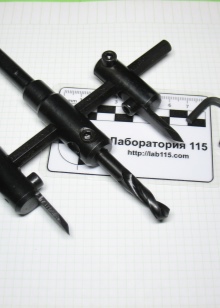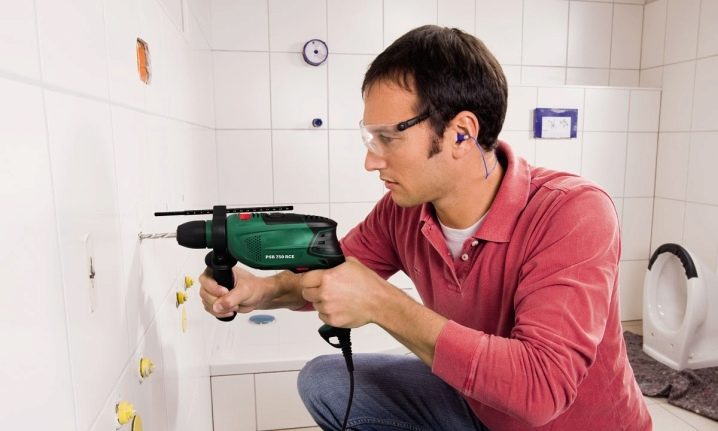Drills for ceramic tiles: subtleties of choice

Ceramic tiles are used almost everywhere today, since the material is practical and beautiful. Products can withstand high humidity as well as exposure to various chemicals. A feature of this product is high strength and fragility at the same time, therefore, processing of products is carried out only with special tools. Tile drills are unique mechanisms that allow you to make holes with minimal damage to the structure of the top layer.

Drilling principles
Tiles are made from baked clay, the surface of which is covered with a special glaze. Both substances are fragile, and therefore, a sharp impact on them can lead to splitting of the workpiece.
In order to properly drill ceramic tiles, you should adhere to several rules:
- If you need to drill a tile that has not yet been laid, then it can be soaked in water for 30 minutes. This will slightly soften the structure of the clay, prevent it from cracking quickly.
- It is advisable to place the holes in the tile at a short distance from the end, but not less than 2 cm. If you install the drill too close, this can lead to chips or cracks.


- Before starting work, you should additionally moisten the surface of the product with water.
- You only need to drill holes from the front side. If the drill is located from the inside, then this will lead to the formation of large chips on the decorative layer.
- The glossy surface does not allow for precise drill alignment. To prevent slipping, you should scratch the top layer a little with the help of special taps.

Drill types
Drilling quality in most cases depends on the tool you plan to use.
For such purposes, several types of drills are often used:
- Diamond. Drills of this type represent a cylindrical structure. These products are the most practical and demanded, but in everyday life they can be found quite rarely, since they are distinguished by their high cost.
- Victory. Drills of this type are intended for working with concrete. Today, many experts use them for the processing of ceramics. Products perfectly withstand loads, and also easily cope with durable tiles. It should be noted that the price for such products is much lower, therefore, winder drills are often used both in everyday life and in industrial construction.




- Lance-shaped. The tip of this instrument forms a kind of feather. Pen drills are designed to work with tiles. The hardness of the "feather" is much higher than the hardness of the vanquished, although it is inferior to the diamond. This option is optimal if you need to make high quality holes of various sizes.
- "Ballerina". This is a kind of nib drills. This tool consists of a central tip and a retractable cutting body. This design allows you to change the diameter of the hole. It is suitable for working only with tiles, as it destroys only the top layer. To get a hole, you need to knock out the marked contour.



In terms of dimensions, there are many types of drills on the market.
The most common are products with a diameter:
- 3 mm;
- 6 mm;
- 8 mm;
- 10 mm;
- 12mm and so on.
Please note that "ballerinas" are also of non-standard size.Diamond bits are distinguished by a significant diameter, therefore they are not referred to as drills. The principle of their operation is identical to the considered modifications.


How to choose for different hole sizes?
In most cases, the drilling of ceramic tiles is carried out after fixing it to the wall or floor (under a socket or toilet drain pipe). The best option for such work will be drills that make through holes. Their use allows you to get a hole immediately ready for use. Please note that the drills are not universal and are only intended for ceramics. If there is reinforced concrete or other building material under the tiles, then it is necessary to drill it only with specialized tools.

For the little one
Small holes in the wall tiles are made for the purpose of placing dowels or other supporting elements in them. The best option for such work will be diamond or feather drills. Their cost is quite high, so it is impractical to use these tools for one-time drilling. In this case, it is better to choose a winning drill of the required size. It will do a great job with tiles.

If you have to work additionally with glass, then it is advisable to use only diamond tools. They easily destroy the solid structure of this material, minimizing the risk of cracking.


For the big
The formation of holes for pipelines is not always possible with classical drills, since they have a small diameter. This problem can be solved with crowns. Outwardly, these tools are small cylinders of various diameters. Diamond grit is applied to the outer surface of the bit, which is held by soldering. Crowns are versatile mechanisms that can work with both tiles and porcelain stoneware. The only drawback is their high cost, so it is irrational to buy a crown if you only need to make one hole. It is better to ask a familiar specialist for the tool or apply alternative methods of processing.

To get the perfect hole, there are a few simple rules to follow when working with crowns:
- Drilling is performed only at minimum speed. Drilling the tiles too quickly will result in chips or small cracks.
- The crown should be constantly cooled with water. To do this, you can simply pour liquid from a bottle on the tool. Such a measure will eliminate overheating of the working surface, which will affect the duration of the product. To exclude overheating, it is advisable to periodically remove the tool from the hole and analyze its condition.

If there are no special tools
Ceramic tiles are often laid by people who do not professionally process them. This usually means that there is no special drilling tool available. There are several ways to solve this problem:
- Saw for metal. In order for it to be suitable for processing tiles, it must be equipped with a diamond thread. With this tool, you can get different types of holes. Their quality will not be particularly high, but if it is not important, then the saw will be a great helper. To start working with it, you should drill a small hole in the tile, insert a thread into it. For more accurate cutting, it is advisable to draw the outlines of the shape to be removed. Cutting is carried out slowly, without strong pressure on the thread.



- Drills for concrete or metal. If you urgently need to make one or more holes in the wall, then you can use these tools. They are not technically meant for tiles, so you just throw them away after drilling. However, concrete drills are quite durable, they can serve for quite a long time.
- Bulgarian. This tool is intended for cutting tiles, but if you want to, you can use it to cut a semicircle at one of the ends of the element.The quality of the edges will be low, but if such an area is hidden, then the quality will not play a special role. For processing ceramic tiles, you should complete the grinder with a diamond wheel. Do not use conventional attachments for this, as they are not intended for such complex tasks.


It is often necessary to get a large hole inside the web. It can be formed using a small diamond drill. To do this, holes are drilled close to each other along the contour of the circle, and then this area is simply knocked out. You can bring the quality of the ends to perfect using sandpaper.


Useful Tips
The drilling technology for ceramic tiles depends not only on the correct drill, but also on the algorithm used.
To get a smooth hole without chips, you should follow these simple tips:
- Regardless of the drill chosen, drilling is carried out only at low speeds. The rotational speed of the drill should not exceed 100-200 rpm. / min, so it is better to use a tool that adjusts automatically and not just at the push of a button.
- Do not overheat the drill. If you hear a burning smell, remove the instrument and let it cool down. In the future, you should slow down a little so as not to spoil the drill. Some experts recommend that you periodically remove the product and lubricate its cutting area with machine oil. The solution will cool the instrument without allowing it to heat up quickly.

- If you need to accurately align the drill and prevent it from slipping, you should glue masking tape at the drilling site. It will allow the top layer of ceramic to break down without the need to press down hard on the tool. For large crowns, previously prepared templates can be used. These products are wooden or plastic boards in which several holes of a standard diameter are drilled. So, by inserting the crown into the hole, you will prevent it from slipping, and also simplify the work with the tool.
- Try to keep the drill straight while drilling. If you drill at an angle, it will affect not only the parameters of the hole, but also the service life of the drill.
- Buy only brand name drills. This applies to almost all of their types, since such models have already passed the test of time, won the favor of many users.



Choosing a drill for ceramic tiles is not a difficult task today. Here it is only important to decide on its diameter, as well as the amount of work performed. If quality is important to you, then be sure to consult with experienced tilers who will help you choose the best option.
For information on how to make holes in ceramic tiles, see the next video.













The comment was sent successfully.